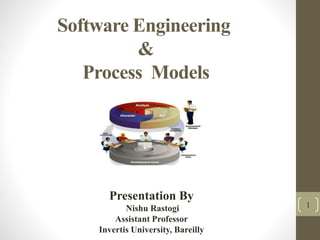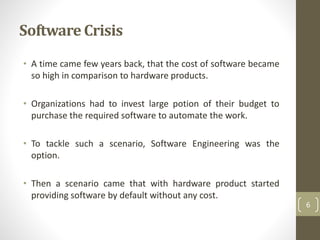The document discusses various software engineering process models including the waterfall model, iterative waterfall model, prototyping model, evolutionary model, rapid application development model, and spiral model. It provides details on the key activities and stages in each model's software development life cycle. The document also compares the different models and discusses when each may be best applied based on factors like the problem's understandability, decomposability into modules, and tolerance for incremental delivery.




![Software Engineering is an engineering approach for
software development.
OR
Software Engineering provides tools and techniques
which can be used to design and develop a software in a
systematic and cost effective manner.
5
What is Software Engineering? [Contd..]](https://image.slidesharecdn.com/unit1-170307073407/85/Software-Engineering-Crisis-and-Process-Models-5-320.jpg)








![SDLC [Contd..]
3. Design
To transform the requirements specified in the SRS
document into a structure that is suitable for
implementation in some programming language.
4. Coding
To transform the logics developed into code by using
syntax of particular programming language.
14](https://image.slidesharecdn.com/unit1-170307073407/85/Software-Engineering-Crisis-and-Process-Models-14-320.jpg)
![5. Testing
To verify and validate the software that it works as
expected.
6. Maintenance
To modify a software product after delivery to correct faults
and to improve performance.
15
SDLC [Contd..]](https://image.slidesharecdn.com/unit1-170307073407/85/Software-Engineering-Crisis-and-Process-Models-15-320.jpg)


![Classical Waterfall Model [Contd..]
18](https://image.slidesharecdn.com/unit1-170307073407/85/Software-Engineering-Crisis-and-Process-Models-18-320.jpg)


![Iterative Waterfall Model [Contd..]
Once a defect is detected:
We need to go back to the phase where it was
introduced.
Redo some of the work done during that and all
subsequent phases.
Therefore, we need feedback paths in the classical
waterfall model.
21](https://image.slidesharecdn.com/unit1-170307073407/85/Software-Engineering-Crisis-and-Process-Models-21-320.jpg)
![Iterative Waterfall Model [Contd..]
22](https://image.slidesharecdn.com/unit1-170307073407/85/Software-Engineering-Crisis-and-Process-Models-22-320.jpg)

![Prototyping Model [Contd..]
24
Requirement
Gathering
Quick
Design
Refine
Requirements Build Prototype
Customer Evaluation of
Prototype
Design
Implement
Test
Maintain](https://image.slidesharecdn.com/unit1-170307073407/85/Software-Engineering-Crisis-and-Process-Models-24-320.jpg)



![Evolutionary Model [Contd..]
28
A
B
C
A A
B](https://image.slidesharecdn.com/unit1-170307073407/85/Software-Engineering-Crisis-and-Process-Models-28-320.jpg)




![RapidApplication Development [Contd..]
33
Requirements
Planning
User Design Construction
Cutover](https://image.slidesharecdn.com/unit1-170307073407/85/Software-Engineering-Crisis-and-Process-Models-33-320.jpg)
![1. Requirement Planning
Combines elements of the system planning and systems
analysis phases.
It ends when the team agrees on the key issues and
obtains management authorization to continue.
2. User Design
Users interact with systems analysts and develop models
and prototypes.
User Design is a continuous interactive process that
allows users to understand and modify the system. 34
RapidApplication Development [Contd..]](https://image.slidesharecdn.com/unit1-170307073407/85/Software-Engineering-Crisis-and-Process-Models-34-320.jpg)
![3. Construction
Tasks are programming and application development like
coding, unit-integration and system testing.
4. Cutover
Tasks include testing, changeover to the new system, and
user training.
New system is built, delivered, and placed in operation
much sooner.
35
RapidApplication Development [Contd..]](https://image.slidesharecdn.com/unit1-170307073407/85/Software-Engineering-Crisis-and-Process-Models-35-320.jpg)

![Spiral Model [Contd..]
37](https://image.slidesharecdn.com/unit1-170307073407/85/Software-Engineering-Crisis-and-Process-Models-37-320.jpg)
![1. Identify objectives of the phase, examine the risks
associated with these objective.
Risk is any adverse circumstance that might hamper
successful completion of a software project.
2. Find alternate solutions possible
38
Spiral Model [I- Quadrant]](https://image.slidesharecdn.com/unit1-170307073407/85/Software-Engineering-Crisis-and-Process-Models-38-320.jpg)
![ For each identified project risk, a detailed analysis is
carried out.
Steps are taken to reduce the risk.
For example, if there is a risk that the requirements are
inappropriate, a prototype system may be developed.
39
Spiral Model [II- Quadrant]](https://image.slidesharecdn.com/unit1-170307073407/85/Software-Engineering-Crisis-and-Process-Models-39-320.jpg)
![ Develop and validate the next level of the product.
Review the results achieved so far with the customer
and plan the next iteration around the spiral.
With each iteration around the spiral progressively more
complete version of the software gets built.
40
Spiral Model [III &IV - Quadrant]](https://image.slidesharecdn.com/unit1-170307073407/85/Software-Engineering-Crisis-and-Process-Models-40-320.jpg)

![ Evolutionary model is suitable for large problems
can be decomposed into a set of modules that can be
incrementally implemented,
incremental delivery of the system is acceptable to
the customer.
Spiral model
suitable for development of technically challenging
software products that are subject to several kinds of
risks.
42
Model Comparison [Contd..]](https://image.slidesharecdn.com/unit1-170307073407/85/Software-Engineering-Crisis-and-Process-Models-42-320.jpg)


